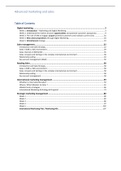Advanced marketing and sales
Table of Contents
Digital marketing ..................................................................................................................... 3
Week 1: Introduction – Marketing and Digital Marketing............................................................................ 3
Week 2: Understand the market, discover opportunities and potential customers (prospects)................. 9
Week 3: The role of DM to engage, acquire potential customers and maintain current ones .................. 16
Week 4: New value propositions through Digital Marketing ..................................................................... 18
Week 5: Omnichannel strategy .................................................................................................................. 19
Sales management ................................................................................................................. 22
Introduction and Sales Strategy .................................................................................................................. 22
Sales in B2B vs. B2C environment ............................................................................................................... 29
Sales channels in B2B & B2C ....................................................................................................................... 35
Sales concepts and Settings in the complex international environment .................................................... 38
Relationship selling ..................................................................................................................................... 44
Key account management (KAM) ............................................................................................................... 50
Reading Sales......................................................................................................................... 58
Introduction and Sales Strategy .................................................................................................................. 58
Sales in B2B vs. B2C environment ............................................................................................................... 58
Sales concepts and Settings in the complex international environment .................................................... 58
Relationship selling ..................................................................................................................................... 58
Key account management .......................................................................................................................... 58
International marketing management .................................................................................... 59
Whether to Internationtionalise? ............................................................................................................... 59
Where / Which Markets to Enter ? ............................................................................................................. 61
eMarket entry strategies............................................................................................................................. 66
International Marketing & Strategy & Program? ........................................................................................ 73
Strategic marketing management ........................................................................................... 80
Week 1 ........................................................................................................................................................ 80
Week 2 ........................................................................................................................................................ 82
Week 3 ........................................................................................................................................................ 86
Week 4 ........................................................................................................................................................ 97
Week 5 ...................................................................................................................................................... 102
International Marketing Plan / Marketing Mix ....................................................................................... 107
,Advanced marketing and sales
,Advanced marketing and sales
Digital marketing
Week 1: Introduction – Marketing and Digital Marketing
Marketing = Create value for customers and build customer relationships, capture value in
return.
PROVIDE Value: what is it that people are looking for?
Customers: the people that ultimately buy and use your products. What are the
values they are looking to get fulfilled?
Relationships: when people start to (consider to) buy your products, a relationship
starts to develop between your company and this customer.
CAPTURE value: as customers choose your product, they will pay in some shape or
form for your product: this is the ultimate goal of any company: making money. Or
as Kotler states it: Capture Value in Return
Value cycle
Need= State of deprivation
Want= form that a need take
Demand= wants backed with buying power
Marketing mix P VALUE
1. Product
2. Price
3. Promotion
4. Place
Marketing mix save NEED
better incorporates the needs of + benefits to the customer
1. Solution (Consumers must be able to understand how features of a
product or service solves problems)
2. Access (Make sure your customers can easily access your business
online; when, where and how they want to.)
3. Value (Emphasize the value your product will bring to customer’s lives,
while exploring different business models)
4. Education (Educate customers about the value products and services
deliver to customers, and build trust with them as part of that process)
Customer
journey
, Advanced marketing and sales
Prior and after the decision to buy and use a product, there are various steps customers go
through. At each step a CONVERSATION takes place from 1 phase to the next. Some people
will convert all the way to becoming a loyal customer for many years. Others drop out
somewhere along the way.
It is the role of marketeers to understand why certain people convert at a given step, and
others drop out. Using the massive amounts of data that DIGITAL provides, we will explore
as we go through this course how DATA can help marketeers to set very clear goals based
on data analyses, monitor and measure progress so that the quality of decisions and the
success of actions can be optimized.
But the Customer Journey does not end with the purchase of the product. Many believe
that once the sale of a product is achieved, it all ends: the money is in the bank (the value is
captured).
However, once people buy a product, they start to experience that product. If that is a
positive one, they will possible start to recommend that product to others. In the READING
2 you have been asked to read, these people are called ADVOCATES. They are people that
influence their networks deliberately, or without purpose to buy that same product by
talking positively about their experience with the product.
Eventually, they will likely have to re-buy a version of that product. That can be as easy as a
next bottle of wine or ketchup, but also a new TV, car or something like that.
What the aim of marketeers is, is that consumers not even consider another brand, but
immediately go for a “rebuy”. When that happens, they are in what we call “the Loyalty
Loop”
Loyal customers are on average 5 – 10 times more profitable than acquiring new customers.
When converting people into customers for the first time, companies must advertise,
educate and stimulate POTENTIAL customers to become REAL customers. That often takes a
lot of time and efforts (and thus MONEY). Loyal customers that don’t even consider another
brand, are as such very profitable.
What is a big balancing act for marketeers in all of this, is attracting new customers through
for instance promotions when buying something for the first time. Those promotions
typically excluded existing customers. Many marketeers are very focused at CONVERTING
NEW CUSTOMERS. They do that so actively, that they ignore to take good care through
other types of promotions focused at LOYAL CUSTOMERS. As a result, they add NEW
CUSTOMERS actively, at a high cost, while loosing customers at the same time that feel
underappreciated and ignored.
In Marketing we call this the LEAKY BUCKET THEORY.







